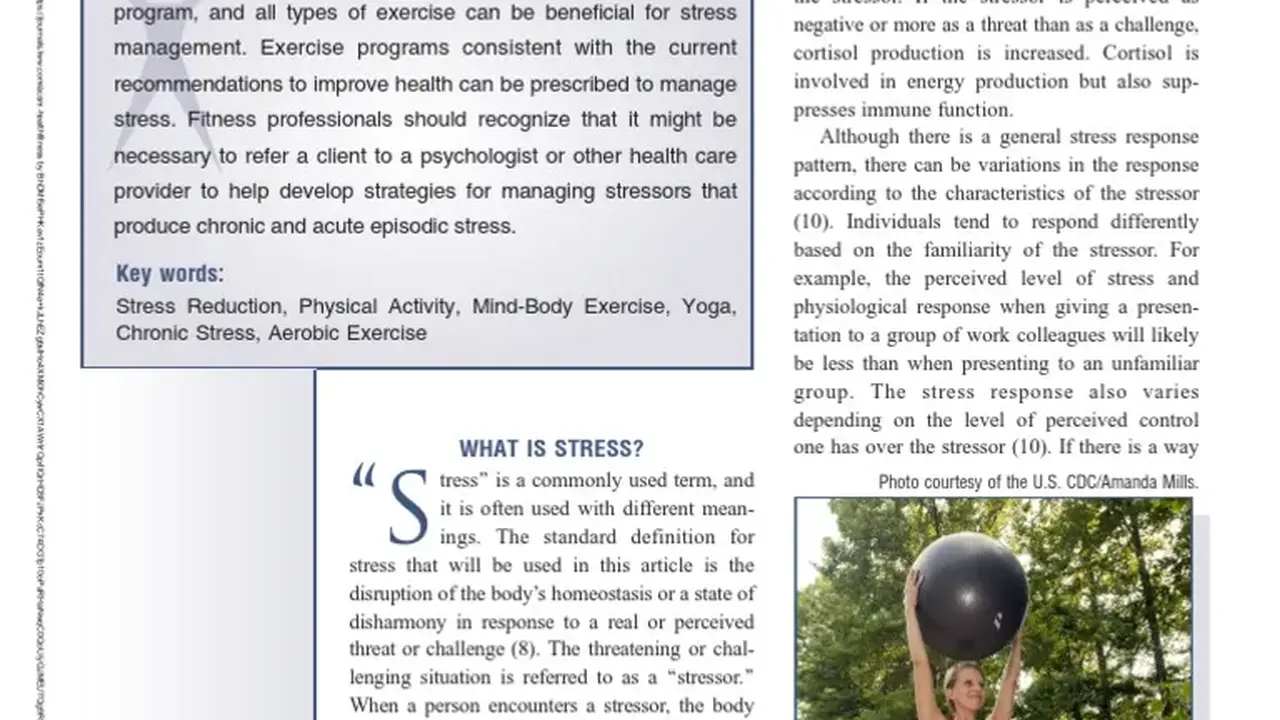The Role of Exercise in Managing Stress and Anxiety
Sample meta description.

Understanding Stress and Anxiety The Mind-Body Connection
Hey everyone! Let's talk about something super common these days: stress and anxiety. Seriously, who *isn't* feeling it? But what if I told you that one of the best tools for managing that gnawing feeling is something you already have access to? Yep, you guessed it: exercise! It's not just about getting ripped abs (although, that's a nice bonus!), it's about the powerful connection between your mind and body. When you're stressed, your body reacts. Think about it: tense shoulders, racing heart, maybe even a clenched jaw. Exercise helps break that cycle.
Think of stress hormones like cortisol as little alarms going off in your body. Regular physical activity helps regulate these hormones, reducing their impact and making you feel calmer. Plus, exercise releases endorphins, those feel-good chemicals that act as natural mood boosters. It's like a little party happening in your brain every time you move!
Exercise Types for Stress Relief Finding Your Perfect Fit
So, what kind of exercise are we talking about? The awesome thing is, there's no one-size-fits-all answer! The best exercise for stress relief is the one you actually *enjoy* doing. Let’s look at some options, and how they can help with stress and anxiety.
Cardio for Anxiety Reduction Boosting Your Mood and Energy
Cardio, also known as aerobic exercise, involves activities that increase your heart rate and breathing. This includes running, swimming, cycling, dancing, and brisk walking. These activities are great for reducing anxiety and boosting your mood.
Running: Even a short jog can significantly reduce stress levels. The rhythmic nature of running can be meditative, helping you clear your head and focus on the present moment. Plus, you're getting some Vitamin D if you're running outdoors!
Swimming: The buoyancy of water can be incredibly soothing. Swimming is a low-impact exercise that's gentle on your joints, making it a great option for people of all ages and fitness levels. Plus, it's a full-body workout!
Cycling: Whether you prefer outdoor cycling or indoor cycling classes, pedaling can be a fantastic way to relieve stress. The repetitive motion can be calming, and you can explore new places or enjoy upbeat music in a class.
Strength Training for Stress Management Building Resilience and Confidence
Strength training, also known as resistance training, involves using weights or your own body weight to build muscle strength and endurance. This type of exercise is not just for bodybuilders; it's also incredibly beneficial for managing stress.
Weightlifting: Lifting weights can help you feel more empowered and in control. The focus required during weightlifting can also help you disconnect from stressful thoughts and concentrate on the task at hand.
Bodyweight Exercises: Exercises like push-ups, squats, lunges, and planks can be done anywhere and require no equipment. These exercises are great for building strength and improving your overall fitness level.
Yoga and Pilates for Stress Reduction Enhancing Flexibility and Mindfulness
Yoga and Pilates are mind-body practices that combine physical postures, breathing techniques, and meditation. These practices are excellent for reducing stress, improving flexibility, and enhancing mindfulness.
Yoga: Yoga involves holding various poses (asanas) while focusing on your breath. This practice can help calm your nervous system, reduce anxiety, and improve your overall sense of well-being. There are many different styles of yoga, so you can find one that suits your preferences and fitness level. Hatha, Vinyasa, and Restorative yoga are all popular choices.
Pilates: Pilates focuses on strengthening your core muscles and improving your posture. This practice can help reduce tension in your body and promote relaxation. It's great for improving body awareness and control.
Mindful Movement for Calming the Mind Reducing Mental Clutter
Mindful movement involves paying attention to your body and breath as you move. This type of exercise can help you become more aware of your thoughts and feelings, allowing you to manage stress more effectively.
Walking Meditation: Walking meditation involves walking slowly and deliberately while focusing on the sensations in your body. This practice can help you clear your mind and reduce mental clutter. Find a quiet park or trail, and just focus on the feeling of your feet on the ground.
Tai Chi: Tai Chi is a gentle form of exercise that involves slow, flowing movements. This practice can help improve your balance, coordination, and overall sense of well-being. It's also known for its stress-reducing benefits.
Creating a Stress-Relieving Exercise Routine Practical Tips and Strategies
Okay, so you're convinced that exercise can help. But how do you actually *start* incorporating it into your life, especially when you're already feeling overwhelmed? Here are a few tips:
* **Start small:** Don't try to go from zero to hero overnight. Even 10-15 minutes of exercise can make a difference. * **Find something you enjoy:** Seriously, if you hate running, don't force yourself to run! Experiment with different activities until you find something that clicks. * **Schedule it:** Treat your workout like an important appointment and block off time in your calendar. * **Buddy up:** Working out with a friend can help you stay motivated and accountable. * **Be kind to yourself:** Miss a workout? Don't beat yourself up about it. Just get back on track the next day.Exercise Equipment for Stress Reduction Recommendations and Comparisons
While you don't *need* fancy equipment to get the stress-busting benefits of exercise, sometimes having the right gear can make things easier and more enjoyable. Here are a few recommendations:
Home Gym Essentials for Stress Relief Creating Your Sanctuary
Setting up a home gym can provide a convenient and private space for your workouts. This can be particularly helpful if you feel self-conscious about exercising in public or have a busy schedule.
Yoga Mat: A good quality yoga mat is essential for yoga, Pilates, and other floor exercises. Look for a mat that is thick enough to provide cushioning and has a non-slip surface. Brands like Manduka and Lululemon offer excellent options, ranging from $80-$150.
Resistance Bands: Resistance bands are versatile and affordable, making them a great addition to any home gym. They can be used for a variety of exercises, including strength training and stretching. A set of bands with varying resistance levels typically costs around $20-$50.
Dumbbells: A set of dumbbells is essential for strength training. Start with a lighter weight and gradually increase the weight as you get stronger. A basic set can range from $50-$200, depending on the weight and brand.
Wearable Tech for Stress Monitoring and Motivation Tracking Your Progress
Wearable tech devices like smartwatches and fitness trackers can help you monitor your activity levels, heart rate, and sleep patterns. This data can provide valuable insights into your stress levels and help you track your progress over time.
Fitbit: Fitbit offers a range of fitness trackers that can track your steps, heart rate, sleep, and activity levels. The Fitbit Sense model also includes stress management features, such as EDA (electrodermal activity) scans. Fitbit devices range from $100-$300.
Apple Watch: The Apple Watch is a versatile smartwatch that can track your activity levels, heart rate, and sleep. It also offers mindfulness apps and guided breathing exercises to help you manage stress. Apple Watches range from $300-$800, depending on the model and features.
Garmin: Garmin offers a variety of fitness trackers and smartwatches that are popular among athletes and fitness enthusiasts. These devices can track a wide range of activities and provide detailed performance metrics. Garmin devices range from $200-$600.
Comparison of Exercise Equipment and Wearable Tech
Yoga Mat vs. Resistance Bands: A yoga mat is better for low-impact exercises like yoga and Pilates, while resistance bands are better for strength training and flexibility exercises. Yoga mats are generally more expensive than resistance bands.
Dumbbells vs. Bodyweight Exercises: Dumbbells offer more resistance than bodyweight exercises, making them more effective for building muscle strength. However, bodyweight exercises require no equipment and can be done anywhere.
Fitbit vs. Apple Watch: Fitbit is more focused on fitness tracking, while the Apple Watch is a more versatile smartwatch with a wider range of features. The Apple Watch is generally more expensive than Fitbit devices.
Real-Life Scenarios How Exercise Fits Into Your Day
Let's get real. Life is hectic. Here are a few scenarios and how exercise can actually fit in:
* **The "I'm too busy" Scenario:** Lunch break power walk! Even 20 minutes can make a difference. Or, try a quick 7-minute workout app. * **The "I'm exhausted after work" Scenario:** Gentle yoga or stretching before bed. Focus on relaxation, not pushing yourself. * **The "I hate the gym" Scenario:** Find an activity you genuinely enjoy! Hiking, dancing, rock climbing, even gardening counts!Pricing Considerations Investing in Your Well-being
Let's be honest, exercise can sometimes come with a price tag. Gym memberships, equipment, classes... it can add up. But think of it as an investment in your mental and physical health. There are plenty of free options too! Walking, running outdoors, bodyweight exercises... the possibilities are endless.
:max_bytes(150000):strip_icc()/277019-baked-pork-chops-with-cream-of-mushroom-soup-DDMFS-beauty-4x3-BG-7505-5762b731cf30447d9cbbbbbf387beafa.jpg)






